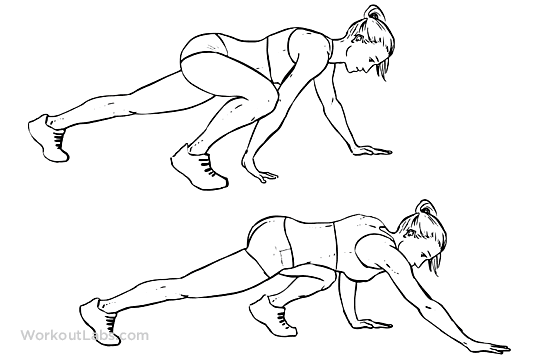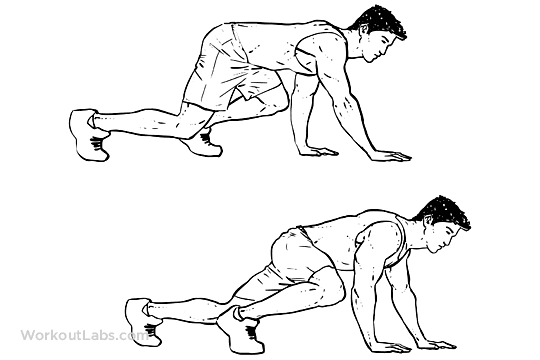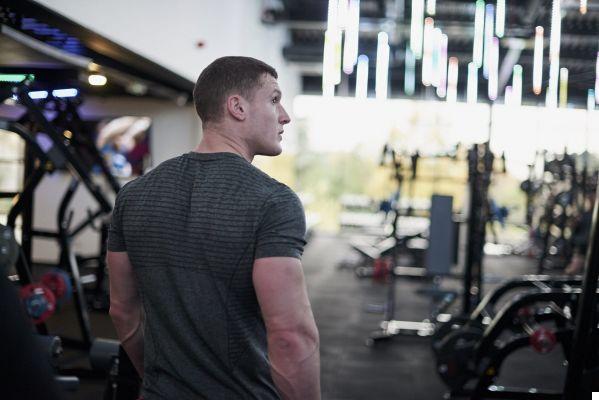The bear crawl is an exercise that wants to simulate the locomotion in quadrupedal support. The sense is not to regress in the evolutionary stages but rather to stimulate different muscles with a different exercise than usual, improve coordination and also get good conditioning.
Obviously, it does not mean that performing 10 minutes of bear crawl can lead to the same energy expenditure and the same training stimulus as 4 sets of 10 repetitions squats but rather we are talking about less taxing alternatives that still allow you to train with the pleasure of using. your body as the only tool.
For these reasons the bear crawl is certainly an auxiliary exercise to be included at the end of the workout or to be used as an active rest in the days following an intense workout.

execution
The starting position is in quadrupedal keeping the trunk parallel to the ground. This requires the pelvis to remain flexed and not in line with the trunk, concretely the butt must remain slightly raised throughout the exercise. From this position:
- Bring one foot forward and at the same time bring one hand forward. If you want to perform the movement with some control and coordination, you need to use the foot on one side and the hand on the other side. If you take off your left foot and left hand it is very likely that you will fall to the left because the center of gravity falls off the support base and there is no core muscle that can maintain the position in this situation. If you decide to work with the foot and hand on the same side, you must first move one limb forward and then the other. This variant is much easier than the cross variant both in terms of muscle work and in terms of coordination
- Hold the position for a second and then perform the same advance for the other foot and the other hand.
- Continue like this until you miss a correct execution or for the desired time or repetitions
It is important to constantly keep the pelvis back towards and the abdominals contracted. When advancing with the hand and foot it is useful to exhale, hold the position while inhaling and continue in this way. The elbows can remain extended or flexed, the first option allows to work more the stabilizers of the scapula while the second variant involves more the arm muscles. The most difficult part of the movement is certainly the transition and therefore if you want to make the exercise more difficult it is sufficient to extend the duration of this.

Muscles involved
In the crossed variant, that is, if you advance your left foot and right hand at the same time, the work of the abdominal muscles is important. The rectus abdominis must prevent the extension of the lower back and keep the pelvis back towards, the obliques stabilized and avoid falling to the side or turning.
The buttocks must work to keep the pelvis back towards and stabilize the trunk in relation to the legs. In the variant with outstretched arms, if the shoulder blades are kept protracted and lowered, the dentate and the lower trapezius are put to the test.
These must support a large part of the weight of the trunk resting on one arm. If you try to keep your shoulders extra rotated and then rotate your biceps forward, the rotator cuff muscles work to stabilize the humeral head and keep it externally rotated. In the variant with bent elbows it is more difficult to keep the shoulders extended, depressed and extra rotated but the triceps are constantly recruited.

Common mistakes
There can be several errors, here are some:
- Taking "steps" that are too short. The aim of the exercise is above all to train the core to prevent perturbations and instability. If you bring your foot forward a little and your hand a little forward, you change little compared to the stable position and therefore the work of the core muscles is reduced. This aspect can be considered a progression of the exercise and the most difficult variation consists in bringing the foot towards the hand and the hand as far forward as possible. This greatly increases the ROM of this exercise and consequently greatly increases the instability and mobility required.
- Swing with the body in the transition phase. We tend to do this to reduce the work of the core muscles, especially the oblique muscles. Moving to one side puts you in a more advantageous position in terms of stability. The goal of the exercise is to work the stabilizing function of these muscles and therefore it is necessary to keep the trunk, pelvis and legs in position while making the transition.
- Transition too quickly. Generally this happens to reduce the difficulty of the exercise or because you are not master of this phase and therefore you move quickly to avoid falling. If you do not have the skills to perform the transition, simply regress the exercise by switching to exercises such as "spider plank" or front and side plank
Progressions
For many, the free body variant can be simple. A good idea might be to wear a weighted robe. This significantly increases the anti-extensor work of the rectus abdominis as well as the anti-rotation work of the obliques. Another option would be to use a belt to attach discs to and let them dangle in front between the pelvis and the ground.
The difficulty is greater than the previous progression because when you move the weight tends to oscillate and therefore a lateral and frontal moment is created which is greater the more the added weight is. A last variant could be to place a disc on the lumbar area and perform the exercise without dropping it. In this case the movement must be very controlled.


























